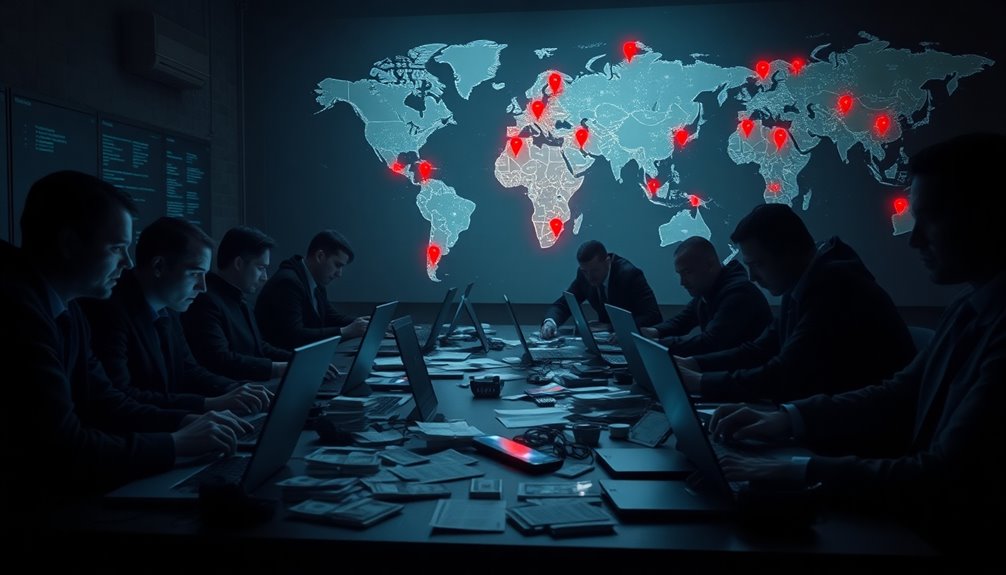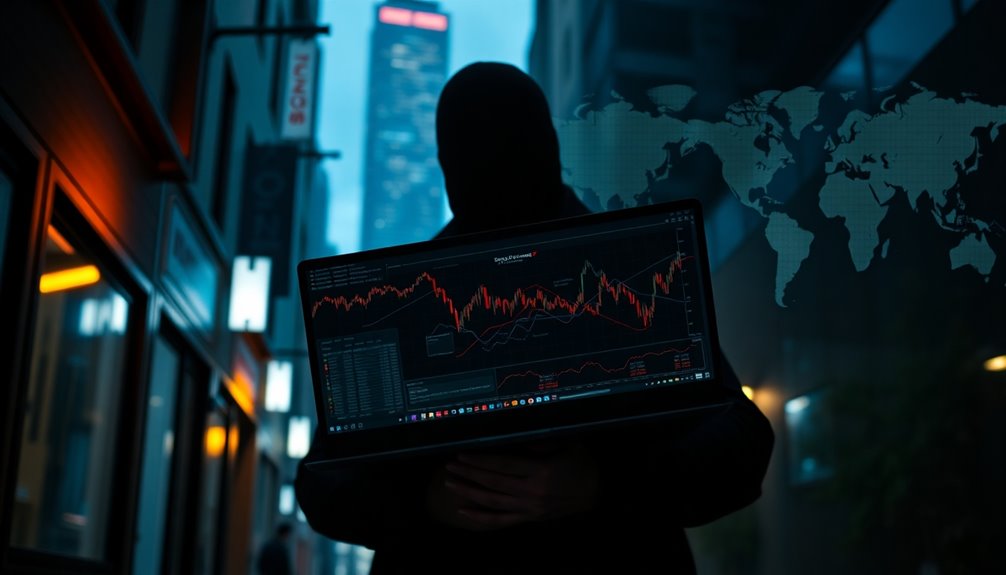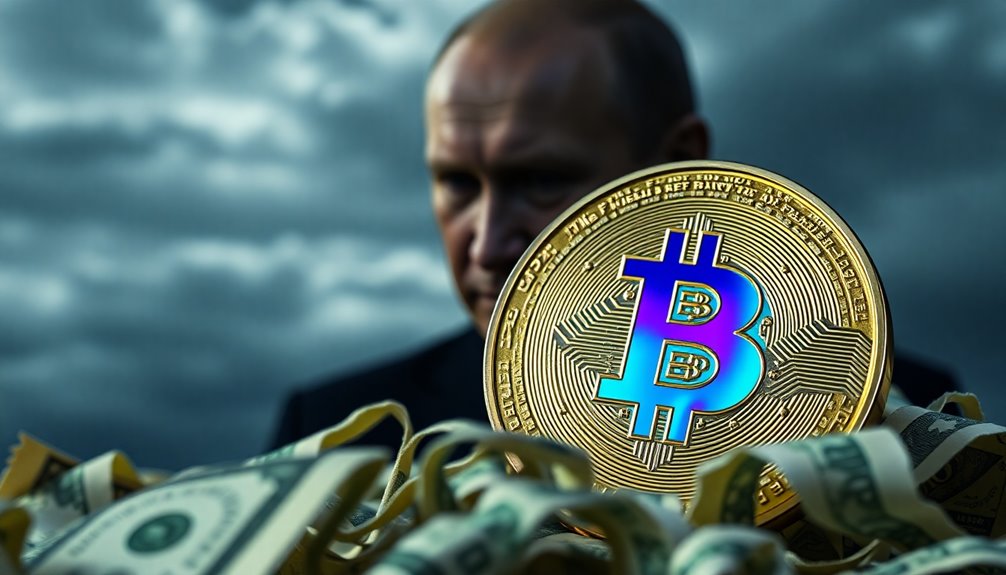The U.S. Treasury's recent operations have exposed a hidden network of operatives who've turned Russian illicit funds into tools against global stability. These operatives manipulate various money laundering techniques, including cryptocurrency schemes and real estate acquisitions, to obscure the origins of these funds. Key figures within this network exploit weaknesses in international sanctions, affecting Russia's economy and disrupting supply chains worldwide. Their activities pose significant risks to global financial systems. To grasp the full scale of their operations and understand the potential implications for the future, you'll want to explore deeper into the intricate details surrounding these events.
Key Takeaways
- Undercover operatives are using intelligence to trace and disrupt Russian money laundering networks, targeting their financial operations globally.
- The U.S. Treasury is implementing strict sanctions and monitoring to prevent illicit funds from supporting military activities in Ukraine.
- Key figures in Russian money laundering, such as George Rossi and Elena Chirkinyan, are being scrutinized for their roles in evading sanctions.
- Advanced techniques like cryptocurrency mixes and real-estate laundering complicate efforts to track Russian funds, prompting increased regulatory oversight.
- The economic impact of sanctions has led to a significant reduction in Russian financial stability, making it harder for operatives to conceal illicit activities.
Overview of Money Laundering Networks

Money laundering networks operate through intricate systems designed to obscure the origins of illicit funds. You'll find that these networks facilitate a range of serious criminal offenses, threatening the integrity of the financial system. Each year, an alarming 2% to 5% of global GDP—between EUR 715 billion and 1.87 trillion—is laundered, making it a pressing global issue that demands international cooperation. These networks utilize various techniques to disguise "dirty money." The placement phase injects illicit funds into legitimate financial systems, while layering involves numerous transactions that distance the money from its illegal origins. Integration follows, where laundered money is then disbursed from seemingly legitimate accounts. Methods like real-estate laundering, casino laundering, and trade-based laundering are common, and the rise of digital money laundering through cryptocurrencies further complicates matters. Despite regulatory efforts, the number of money laundering cases continues to increase, driven by geopolitical shifts and technological advancements. The U.S. Department of the Treasury's role is crucial in combating these networks, emphasizing the need for robust enforcement and international collaboration. As you navigate this complex landscape, it's vital to recognize that effective anti-money laundering (AML) strategies are imperative to combatting the staggering figures associated with this global issue. Understanding these networks helps in recognizing the broader implications for society and the economy.
Key Figures Behind the Operations

While traversing the complexities of money laundering networks, one can't overlook the key figures orchestrating these operations. At the helm, you have George Rossi, a Ukrainian national believed to lead the TGR Group. He's heavily involved in international money laundering and sanctions evasion, working closely with co-leader Elena Chirkinyan. This duo is part of a broader effort to combat the sanctions evasion that threatens global financial stability.
This Russian national excels at converting illicit funds into cryptocurrency and has a knack for facilitating property purchases in Western countries using laundered money. Together, they collaborate with Ekaterina Zhdanova, the head of the Moscow-based Smart Group. Zhdanova is infamous for her role in laundering ransomware payments and orchestrating international transfers of both fiat and cryptocurrency. Significantly, she assisted a Russian oligarch in transferring over $100 million abroad.
Khadzi-Murat Dalgatovich Magomedov, another key player, coordinates bulk cash and cryptocurrency money laundering efforts alongside Zhdanova. Linked to organized crime, he's also sanctioned by the U.S. Treasury's OFAC. Collectively, these individuals form a formidable network, exploiting digital assets and non-compliant exchanges to facilitate their illicit activities, making them critical targets in the fight against global financial crime.
Techniques Used for Money Laundering

When you look at money laundering techniques, cryptocurrency conversion methods stand out as a popular choice.
Many criminals use property acquisition strategies to disguise their illegal gains, while pre-paid cards help obscure the source of funds. An estimated $2 trillion is laundered annually, highlighting the scale of illicit activities masked in today's financial landscape.
Understanding these methods is essential for recognizing how illicit activities are masked in today's financial landscape.
Cryptocurrency Conversion Methods
Often, cryptocurrency conversion methods are employed by illicit actors to launder funds, making it essential to understand these techniques.
One common approach is using nested services, where smaller exchanges leverage APIs from larger exchanges. This method often involves over-the-counter (OTC) brokers, enabling anonymity for large transactions. Groups like the Lazarus Group have exploited these services to conceal their activities. Moreover, this technique takes advantage of weak AML processes prevalent in many exchanges, further facilitating illicit transactions.
Another technique is smurfing and fragmentation, which breaks down significant transactions into smaller ones to evade detection. By distributing funds across multiple wallets or accounts, it becomes increasingly challenging to trace the origins of the money.
On-chain money laundering mixers further complicate tracking efforts. These mixers blend cryptocurrencies from various sources, obscuring the blockchain records and increasing user anonymity.
Property Acquisition Strategies
Illicit actors frequently turn to property acquisition strategies to launder money, leveraging the real estate market's complexities. They often use third-party bank accounts to deposit and withdraw illicit funds for property purchases. Complicit individuals, known as "cleanskins," may transact on behalf of the launderer, keeping their identity off the title. By filtering money through lenders, they obscure the origin of funds used to pay mortgages on these properties. In fact, AUSTRAC reported that over $1 billion was laundered through Australian real estate by Chinese interests in 2020, highlighting the scale of the issue.
Manipulating property valuations is another common tactic. Collusion between buyers, sellers, and agents can lead to inflated or deflated property prices, while undisclosed cash payments bridge the gap between actual and stated values. Additionally, buyer collusion and complex transactions further complicate the laundering process. Multiple buyers might conspire to drive up bids, while front companies apply for loans to disguise illicit funds.
Pre-Paid Card Utilization
Pre-paid cards have become a popular tool for money laundering due to their convenience and anonymity. You might find these cards appealing for various reasons, but they often serve illicit purposes. Criminals utilize them in three main stages: placement, layering, and integration.
| Stage | Techniques Used |
|---|---|
| Placement | Purchase large quantities of pre-paid cards; transport them across borders to avoid scrutiny. |
| Layering | Spend funds on high-value electronics; redeem or resell cards worldwide. |
| Integration | Use cards for legitimate purchases like real estate; fund unlawful activities globally. |
In the placement stage, illegal funds are injected into the financial system through card purchases. During layering, criminals cycle these funds rapidly by buying goods. Finally, integration occurs when laundered money is used for legitimate transactions, creating a facade of legality. Prepaid cards are particularly appealing to criminals due to their anonymity in transactions, which allows them to evade detection more effectively.
Be aware of red flags, such as unusual transaction volumes or patterns. Anti-money laundering (AML) measures are essential in detecting these activities, focusing on cross-border transactions and rapid reloads. Understanding these tactics can help you recognize and combat money laundering effectively.
Impact on Russian State Activities

The Russian state is grappling with financial strain that threatens its core activities and military operations. Despite implementing higher taxes, including a 10% levy on profits for larger companies, budget revenues are falling. The budget remains in deficit, similar to the previous two years, forcing the government to withdraw substantially from the National Welfare Fund to finance essential activities.
With interest rates soaring to 18%, domestic borrowing has become prohibitively expensive, complicating the government's financial strategies. This financial squeeze poses significant challenges for Russia's military efforts. The soaring costs associated with sustaining a long-term war effort clash with diminished revenue streams, creating a precarious financial landscape.
Labor market shortages and employment crises are emerging as the economy strains under the weight of increased taxation and reduced foreign investment. As the war economy struggles, the reliance on higher taxes rather than genuine economic growth becomes starkly evident. Notably, the disruption of financial networks supporting criminal activities further exacerbates Russia's economic challenges.
The interplay of these financial pressures not only threatens military operations but also jeopardizes the overall stability and capabilities of the Russian state in the face of ongoing international challenges.
International Sanctions and Collaborations

Sanctions are shaping the landscape of international relations as over 30 countries rapidly united to impose a complex web of restrictions on Russia.
Led by the US, EU, UK, and Canada, this coalition acts with unprecedented speed and coordination, targeting a major G20 economy and a permanent member of the UN Security Council.
The joint Russian Elites, Proxies and Oligarchs (REPO) Task Force enhances the enforcement of financial sanctions against corrupt oligarchs, while advisories help identify common evasion tactics.
You'll find that sanctions impact sensitive sectors within Russia's military industrial complex, restricting access to advanced technologies and funding for its war efforts.
Over 1,000 international firms have voluntarily boycotted Russia, affecting around 40% of its GDP. Approximately one-third of the global population lives under sanctions regimes, highlighting the widespread implications of these measures.
Financial institutions must engage in strict sanctions screening, legally required in many jurisdictions, to block unauthorized transactions and mitigate legal risks.
This international collaboration also sparks discussions on the potential use of seized oligarchs' assets for Ukraine's reconstruction.
As a result, the world witnesses a historic alignment of nations determined to hold Russia accountable for its aggressive actions.
Economic Consequences of Sanctions

When sanctions hit, you see a noticeable slowdown in global economic growth and disrupted supply chain dynamics. These measures not only affect the targeted country but also ripple through the international market, impacting trade and investment everywhere. As a result, you might notice higher global commodity prices and a more fragmented economic landscape. Additionally, studies indicate significant GDP loss following sanctions imposition, which underscores the widespread economic ramifications of such measures.
Global Economic Growth Slowdown
It's clear that economic sanctions have a profound impact on global economic growth, often pushing target countries into prolonged periods of stagnation. When sanctions are imposed, you can expect a significant decline in GDP growth, with UN sanctions averaging a 2 percentage point drop per year and US sanctions causing a 1 percentage point decrease.
This reduction isn't just a number; it translates into lower GDP per capita—by 25% under UN sanctions and 13% under US sanctions.
All components of GDP suffer, including private consumption, investment, and trade. You'll observe that growth rates decline almost immediately after sanctions are enacted, and recovery remains elusive even after they're lifted. In the case of Russia, despite facing sanctions, there has been a notable strong economic growth observed in early 2024.
Trade takes a hit too, with both exports and imports falling dramatically, forcing target nations to rely on lower-quality suppliers.
Welfare and overall consumption decline sharply, leading to inefficient resource allocation and increased inflation due to elevated import costs.
Monetary tightening follows, with interest rates spiking, further straining companies and households.
In short, sanctions create a ripple effect that slows global economic growth, impacting not only the targeted nations but also the global economy at large.
Disrupted Supply Chain Dynamics
The slowdown in global economic growth reveals the far-reaching consequences of sanctions, particularly when it comes to disrupted supply chain dynamics.
With Ukraine and Russia supplying a significant portion of global wheat, barley, and sunflower oil, the ongoing conflict has led to significant shortages affecting food and beverage companies worldwide. Additionally, the reliance on energy-efficient technology can be crucial for businesses adapting to rising costs associated with the disrupted supply chain.
The war has also impacted the semiconductor industry, as Ukraine is an essential supplier of neon and palladium. This disruption has forced many companies to pause or stop selling certain products due to the lack of necessary materials.
As a result, you're likely to see increased costs and delays in acquiring these commodities.
Sanctions complicate trade and export/import dynamics, threatening billions in transactions between Ukraine, Russia, and other countries.
Payment difficulties with third countries have surged, and Russia's reliance on lower-quality suppliers from places like China and Türkiye further strains the situation.
Consequently, companies face substantial financial risks when they can't sell profitable products without critical parts. In fact, the US Treasury's announcement of additional sanctions in September 2023 further exacerbates these challenges.
As they divert resources to find alternative supply chains, the focus on business growth diminishes, highlighting the profound economic and regulatory challenges posed by these sanctions.
The Role of Cryptocurrency

Utilizing cryptocurrency as a means of circumventing sanctions has become a focal point for rogue actors seeking to exploit the financial system.
While cryptocurrencies provide a seemingly anonymous way to conduct transactions, their effectiveness is limited by the inherent transparency of blockchain technology. Many actors attempt to mask their activities using mixers, privacy wallets, and non-compliant exchanges, but these methods aren't foolproof. Moreover, the rise of stablecoins offers a new avenue for these actors, as they are designed to maintain a constant value, making them attractive for transactions. The mining of Bitcoin, which takes approximately 10 minutes per block, also plays a role in the broader cryptocurrency ecosystem, influencing transaction speeds and costs.
Advanced blockchain analytics can trace illicit activities, making large-scale evasion increasingly difficult.
Regulatory bodies like FinCEN and OFAC guide financial institutions to monitor suspicious transactions. They emphasize recognizing patterns that might indicate sanctions evasion, such as multiple small transactions.
Compliance measures become essential, as tracking transactions involving known sanctioned entities can deter illicit use of cryptocurrencies.
Real-world examples show that while Russian entities have attempted to leverage cryptocurrencies for sanctions evasion, these efforts are often detectable.
The speed and lower fees associated with cryptocurrency transactions aren't enough to outweigh the risks of detection.
Ultimately, blockchain's digital trail serves as a double-edged sword, offering potential for anonymity yet exposing many illicit activities to scrutiny.
Future Implications for Global Economy

As Russia grapples with unprecedented economic challenges exacerbated by sanctions and the fallout from its geopolitical actions, the implications extend beyond its borders, affecting the global economy.
You'll notice that Russia's soaring war expenditures and falling budget revenues create instability, leading to rising inflation and employment crises. This instability compromises not just Russia's economy but also the interconnected global financial system.
Sanctions have isolated Russia, making international transactions difficult and hurting global trade flows. With foreign companies exiting, foreign direct investment plummets, impacting sectors reliant on external markets. The use of digital assets for evading sanctions has further complicated these transactions, creating new challenges for regulatory compliance.
As Russian banks face high interest rates, domestic borrowing becomes increasingly costly, stifling growth.
Looking ahead, the risk of medium-term bankruptcy looms. Russia's creditworthiness has diminished considerably, especially after defaulting on external debt for the first time in decades.
This uncertainty trickles down to global markets, as investors become wary of the ripple effects.
Ultimately, the future of the global economy hinges on Russia's economic trajectory, with its reliance on volatile oil prices and limited access to financing creating a precarious situation that could have far-reaching consequences.
Frequently Asked Questions
How Do Money Laundering Networks Impact Everyday Individuals?
Money laundering networks directly impact you by undermining economic stability and increasing crime.
They distort competition, making it harder for legitimate businesses to thrive, which can lead to job losses. You may face higher taxes because of tax evasion in informal economies.
Additionally, the widening income gap can foster social unrest, affecting your community's safety and cohesion.
What Are the Legal Consequences for Those Involved in Money Laundering?
Imagine you're a cowboy in the Wild West, but instead of gold, you're hiding dirty money.
If you're caught money laundering, you face serious consequences.
First-time offenders might get probation, but repeat offenders can end up in prison for up to 25 years.
The amount of money involved and your role can also influence your sentence.
Plus, you could forfeit three times the amount involved if it's over $100,000.
How Can Individuals Identify Potential Money Laundering Activities?
To identify potential money laundering activities, you should look for unusual transaction patterns, like multiple small deposits followed by a large withdrawal.
Pay attention to cash-intensive businesses and any inconsistencies in their cash transactions.
Monitor transactions involving high-risk countries and watch for large cash deposits without clear sources.
Utilizing advanced technologies, like AI, can help flag irregularities, but staying alert to these warning signs is essential for spotting suspicious activity.
What Role Do Banks Play in Preventing Money Laundering?
Banks play an essential role in preventing money laundering by implementing robust anti-money laundering (AML) programs.
You'll find that they develop compliance programs that monitor transactions and conduct thorough customer due diligence.
By analyzing transaction patterns, they can identify suspicious activities and flag them for investigation.
Additionally, banks report any suspicious activity to regulatory authorities, ensuring they contribute to a broader effort against money laundering and terrorist financing on a global scale.
How Can Cryptocurrencies Be Regulated to Prevent Misuse?
To regulate cryptocurrencies effectively and prevent misuse, you need to implement stricter anti-money laundering (AML) laws and enhance identity verification measures.
Establishing clear guidelines for cryptocurrency exchanges and custodians is vital. You should support industry self-regulation, promoting standard practices among players.
Additionally, fostering collaboration between regulatory bodies and law enforcement will help identify and combat financial crimes.
Continuous customer education on scams and security risks can empower users to protect themselves.
Conclusion
As you reflect on the Treasury's relentless quest against Russian money laundering, it's almost amusing to think that while operatives shuffle money across borders, they inadvertently expose the fragility of our global economy. You'd expect these networks to crumble under pressure, yet they adapt and evolve, like weeds in a garden. So, as the world tightens its grip, it's clear: the more we try to control the cash, the more cunningly it slips through our fingers.









